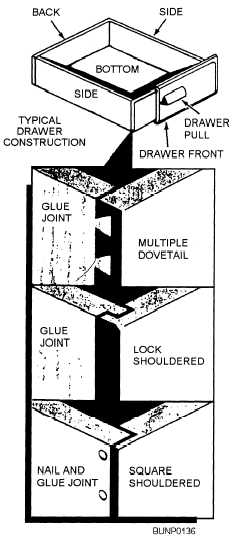should be used with the butt joint. Fixed shelves are dadoed into the sides.
Screws should go through the hanging strips and into the stud framing. Never use nails. Toggle bolts are required when studs are inaccessible. Join units by first clamping them together and then, while aligned, install bolts and T-nuts.
Counter Tops
After the base units are fastened in position, the counter top is laid on top of the units and against the wall. Here are some helpful hints for installing counter tops:
1. Move the counter top, if necessary, so that it overhangs the same amount over the face frame of the base cabinets.
2. Adjust dividers for the difference between the amount of overhang and the desired amount of overhang. Scribe this amount on the backsplash if it has a scribing strip.
3. Cut the backsplash to the scribed line and fit it to the wall.
4. Fasten the counter top to the base cabinets with screws up through the top skeleton frame of the base units. Use a stop on the drill bit so you do not drill through the counter top.
In some cases, backsplashes are not built with scribing strips. To fit the backsplash to the wall, hold the counter top in the desired position. Press the backsplash against the wall at intervals and mark its outside face on the countertop. Remove the countertop and fasten the backsplash to the counter top on the marked lines. Fasten the counter top and backsplash in position.
Another method is to leave off the laminate on the face of the backsplash. Fasten the counter top in position. Hold the backsplash down tight on the counter top and nail it to the wall through its face. Then laminate the face of the backsplash on the job after it has been fastened in position. The disadvantage of this method is that it is difficult to remove the backsplash if the counter top has to be replaced.
DRAWERS
Builders use many methods of building drawers. The three most common methods are the multiple dovetail, lock-shouldered, and square-shouldered methods (fig. 5-13).

Figure 5-13. - Three common types of joints used in drawer construction.
Several types of drawer guides are available. The three most commonly used are the side guide, the corner guide, and the center guide, as shown in figure 5-14, view A.
The two general types of drawer faces are the lip and flush faces, as shown in figure 5-14, view B. A flush drawer must be carefully fitted. A lip drawer must have a rabbet along the top and sides of the front. The lip style overlaps the opening and is much easier to construct.
Drawer dimensions are usually given as width, height, and depth, in that order. The width of the drawer is the distance across the drawer opening. The height is the vertical distance of the opening. The depth is the distance from the front to the back.
Continue Reading